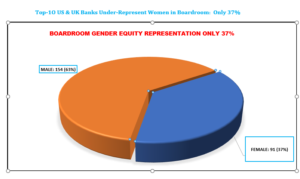The United Nations’ (UN) International Women’s Day of 2022 is marked in the context of climate change, environmental and disaster risk reduction through the theme of ‘Gender equity today for a sustainable tomorrow’.
Certainly, the UN recognises the critical role gender equity plays in the sustainable future of human existence. Besides the UN, society at large recognises women-equity as human-equity, an acquisition through our inherent natural rights of existence. In spite of these natural women/human rights, women remain under-represented in many sectors of society’s corporate boardrooms.
Academia, corporates, policymakers, opinion leaders, governments and organisations continue to support the promotion of gender equity within the spaces of corporate governance. Although an amount of positive strides have been made in gender equity, gender diversity through women representation on corporate boards remains at a low level as the gender gap somewhat continues. Perhaps our society should emulate the Finnish mindset of the gender equity notion as a partnership between women and men, rather than a competition of ‘women versus men’.
In reference to the United States of America, according to the American Bankers Association (ABA) although women represent more than half of the American population, they are consistently under-represented on banking corporate boards.
It is against the backdrop of ABA’s position that this article is developed. In an analysis of top-10 US and UK banks as ranked in 2021, and the boardroom membership on the corporate websites of the following – (JP Morgan, Bank of America, Wells Fargo, Citigroup, US Bank Corp, Truist Bank, PNC Bank, TD Group, Goldman Sachs, Bank of New York, HSBC, Lloyds, RBS, Barclays, StanChart, NBS, Schroders, Close Brothers, Coventry Building, Santander) – 154 are male representing 63 percent, with 91 comprising women representing 37 percent as in the diagram below.
This data analysis may be limited by the scope, hence future study should expand the scope beyond top-10 banks and be extended to other business sectors and a comparative analysis of Europe, North and South America, Asia and Africa. Such a broader study would throw more light on the extent of corporate boardrooms’ gender equity challenges and needs.
Top-1O US & UK Banks Under-Represent Women in Boardroom: Only 37%

The Media Applying Boardroom-Gender-Equity Lens:
Undoubtedly, the media has been contributing to human development. Society is however faced with gender equity challenges across the globe. For instance, for the past 22 years Los Angeles has just appointed its first female Fire Service Chief – this simply suggests how important gender equity is, and the challenging future it poses to equitable human existence.
The media as a social force for informing, entertaining and educating society – and as an instrument for change – is encouraged to accord issues relating to corporate boardroom gender equity with news prominence on its news agenda for social change. “Gender equity today for a sustainable tomorrow”, as expressed by the UN, should transcend beyond climate change and its associated environmental risks/disasters.
In my view, a society that fails to uphold gender equity is equally guilty of promoting what I term as ‘gender-ecosystem disaster’ with a tendency of risking human co-existence and human harmony. As society celebrates International Women’s Day, the media could consider directing its news lenses toward corporate boardroom gender representations and equity-related narratives.
It must however be established that the corporate boardroom gender equity debate should not be confrontational in application, but a mechanism of constructive global dialogue toward sustainable human existence for tomorrow.
Generally, a consistent ethical news editorial agenda on boardroom gender equity issues could create the needed awareness, public trust; and subsequently induce social change across corporates’ boardroom gender representation landscapes.
The writer is a Strategic Corporate Communication Consultant
Email: [email protected]










